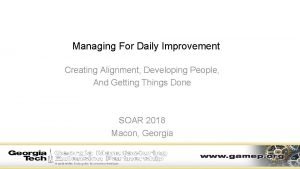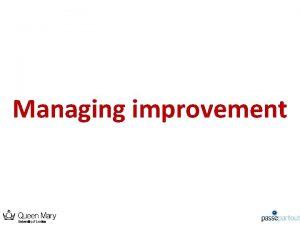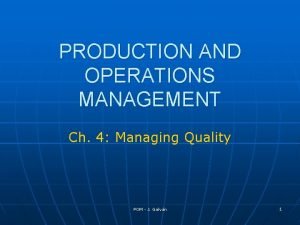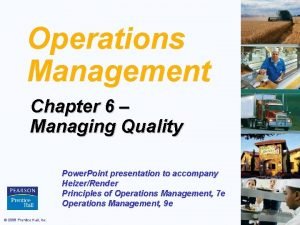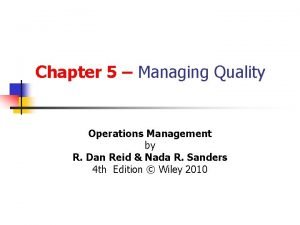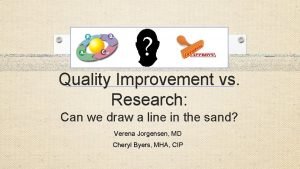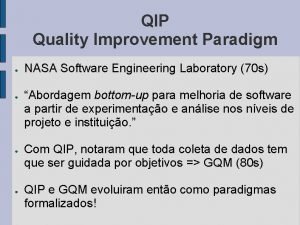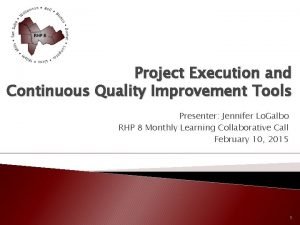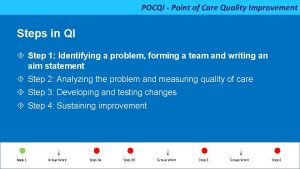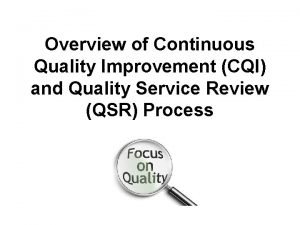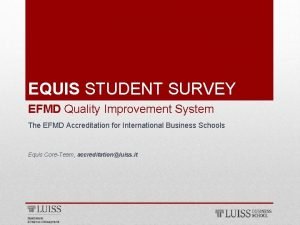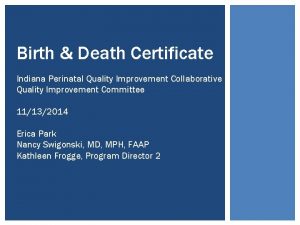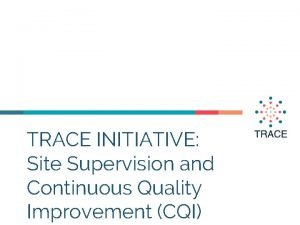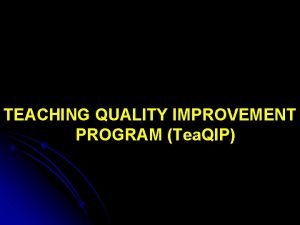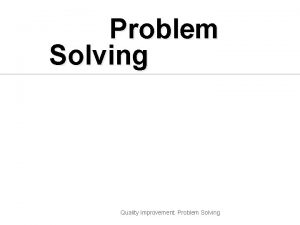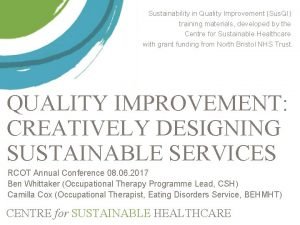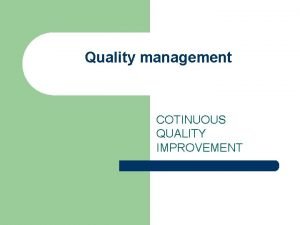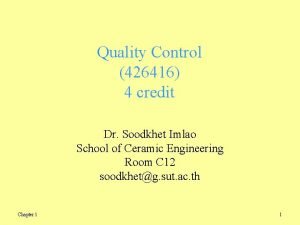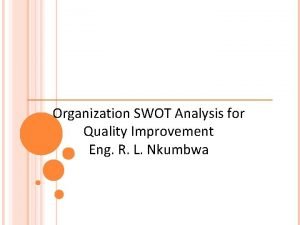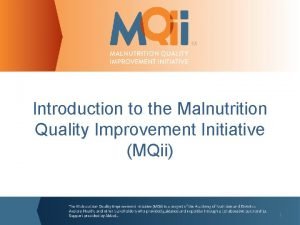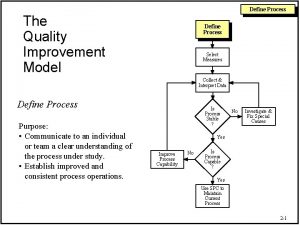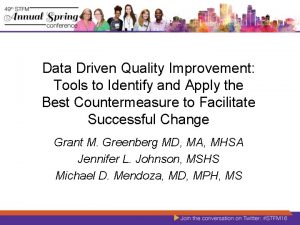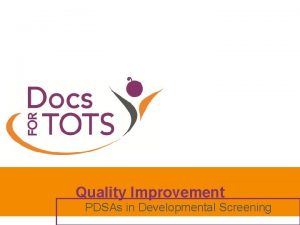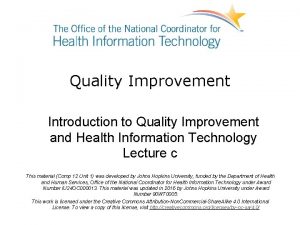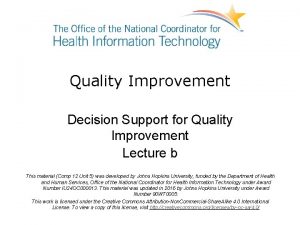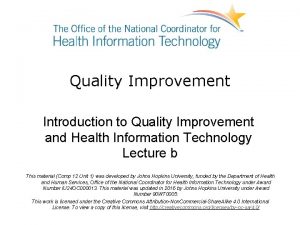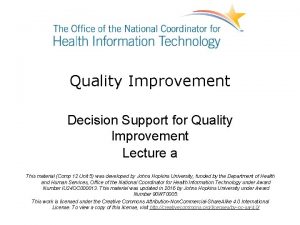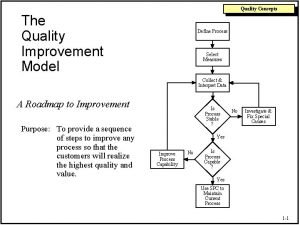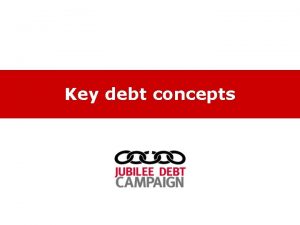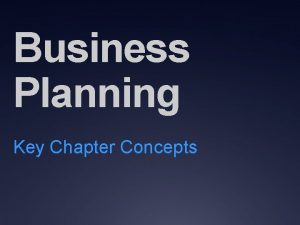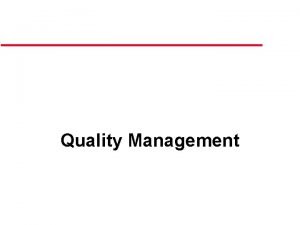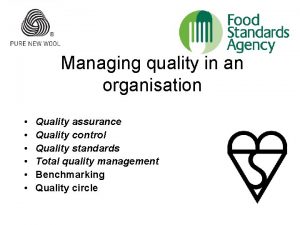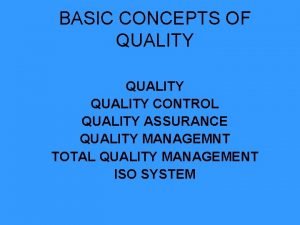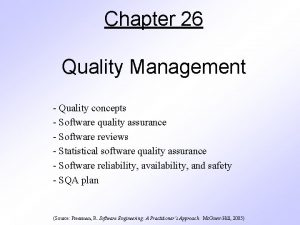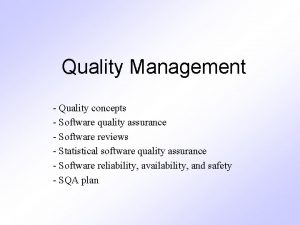Managing improvement Key concepts in quality improvement Practice

























- Slides: 25

Managing improvement

Key concepts in quality improvement Practice Agenda Service improvement techniques Quality models Quality in Higher Education

Quality before the 1970 s l l l Conformance to specifications Engineering led; customers rarely consulted Impact of variation not recognised Everything within spec. = GOOD 95% Good (or less) was good enough Heavy dependence on inspection Reject OK Reject

Ford’s wakeup call l l l Identical gearboxes for the new American Escort were sourced from two plants, one in the US, and one run by Mazda Customer complaints pointed to the US gearbox “Tear downs” of US and Mazda boxes showed both sets of components to be “within spec” After further analysis, the Mazda components showed lower dimensional variation Visual examination showed the Mazda components to be “better made” Mazda “The b******* are making them with love!” Ford LSL USL

The Matsushita Rant We are going to win and the industrial west is going to lose: there’s nothing much you can do about it, because the reasons for your failure are within yourselves. Your firms are built on the Taylor model ; even worse, so are your heads. For you, the essence of management is getting the ideas out of the heads of the bosses into the hands of labour. We are beyond the Taylor model : business, we know, is now so complex and difficult, the survival of firms so hazardous in an environment increasingly unpredictable, competitive and fraught with danger, that their continued existence depends on the day-to-day mobilisation of every ounce of intelligence. For us, the core of management is precisely this art of mobilising and pulling together the intellectual resources of all employees in the service of the firm. We know that the intelligence of a handful of technocrats, however brilliant and smart they may be, is no longer enough. Only by drawing on the combined brain power of all its employees can a firm face up to the turbulence and constraints of today’s environment. - - Extract from a speech by Konosuke Matsushita of the Matsushita Electric Industrial Co. given to visiting European & American managers in 1979

Quality from 1990 s to present l Ideas about Value and Waste strengthen links to customer l Improved Quality reduces costs l Jidoka: fixing problems when and where they occur; using automation with “human intelligence” to improve quality, not just to increase output or reduce headcount l Six Sigma (σ) levels of quality are defining the competitive edge (3 -4 defects per million)

Key principles in quality improvement l Clarity and constancy of purpose l Leadership – Commitment from the top – Effective leadership at all levels l l l Spend time on planning and design Aim for “zero defects” Statistical process control Systemic thinking Preventive, “no blame” approach

Six Sigma l Fundamental objective – Implementation of a measurement based strategy that focuses on process improvement and variation reduction through projects. l DMAIC process is for existing processes falling below specification and looking for incremental improvement. l DMADV process is for developing new processes or products at Six Sigma quality levels Define, Measure, Analyse, Improve, Control Define, Measure, Analyse, Design, Verify

99% Good (3. 8σ) Product or Service 99. 9997% Good (6σ) 20, 000 Articles of post lost per hour Seven 15 minutes/day Unsafe drinking water One minute every seven months 5, 000 Incorrect surgical procedures per 1. 7 week Two per day Short or long landings at major airports 200, 000 Wrong drug prescriptions per year One every five years 68 Is 99% good enough?

Lean Review Agenda Practice HE case studies

Definition of lean The continuous elimination of waste from every business process with the ultimate goal of providing World-Class quality, delivery and service to our customers at the lowest possible cost

Value and waste Value is anything the Customer is prepared to pay for Waste is anything that adds cost but no value to the product or service in the eyes of the Customer

Total cycle time vs. value-added time Industry Process Ave Cycle Time VA Time %VA Time Life Insurance New Policy Application 72 hours 7 min. 0. 16% Consumer Packaging New Graphic Design 18 days 2 hours Footwear Prototype Development 25 weeks 2 days 1. 6% Commercial Bank Consumer Loan 24 hours 34 min. 2. 4% Hospital Patient Billing 10 days 3 hours Motor Vehicle Equipment Financial End-of-Month Closing 11 days 5 hours 0. 14% 3. 8% 5. 6%

4%1% 1% 1% 35% 49% 60% Manufacturing Value Adding Future Value Adding Necessary Non Value Adding Waste 49% Non-manufacturing Source: Hines, Silvi & Bartolini Lean Profit Potential, 2002 LERC, Cardiff Business School

The eighth waste? Entrance Brain Locker DEFINITION INADEQUATE UTILISATION OF THE INTELLIGENCE, SKILLS & KNOWLEDGE OF LARGE SECTIONS OF THE WORKFORCE TO SUPPORT CORPORATE GOALS AND OBJECTIVES Example: • Failure to delegate decision-making as close as possible to the front line

The Ninth Waste? Management behaviour? l Command & Control thinking (JDI!) is incompatible with learning and kaizen l Genschi Genbutsu is not the norm; making decisions remotely based on reports is l Managers are not trained to recognise waste

The Golden Rule l The Golden Rule at Toyota is Genschi Genbutsu (go and see) which helps you: – Recognise, first hand, the wastes which are degrading process capability – Reinforce the (visual) process controls developed by the Gemba (they are watching your every move) – Recognise the daily frustrations which sap enthusiasm in the Gemba – Sponsor or get involved in their kaizen efforts – You can coach their efforts, but you will also learn from them

Case Study 1: Housing benefits

What matters to customers? l l l “I get an answer quickly so that I know whether or not I’m going to get help” “Deliver payments quickly so that I don’t get hassle from my landlord or the Council Tax department” “Make sure my benefits keeps track with changes in my situation…” “You help me through the process” “I can understand the letters & forms” “I don’t mind waiting a bit if I know it is going to be sorted”

Purpose Pay the right money to the right people as quickly as possible

Capability (how well are we meeting the purpose in customer terms? ) l We don’t know! – Because we don’t measure it! l But … we do measure: – BVPIs & position relative to ‘similar’ authorities – Waiting time in reception – Number of cases per day in the back office

So what do customers experience? Ucl = 152 mean = 52

Seeing the whole system “I want to claim” 34%V 66%F 64% passed back Manage queues Hand out forms Take in documents 22%V 78%F Multiple Sorts & Checks Cases fragmented Scanning/Indexing errors 44%V 56%F Handoff Sort Scan Index HO Workers’ activity ‘managed’ 1 -10 cycles to clean (ave. 4) 95% cases over-specified 20% docs. duplicated Letters unclear Allocate 99% claims ‘dirty’ No case ownership CTax fragmentation HO Decide Pay 0 -152 days to pay 3% visit once HO Notify HO Inspect 60% errors Rework HO

Change thinking, improve performance Purpose Measures Pay the right people the right money fast mean = 142 mean = 12 Method Experiment: find & act on causes of variation

The systems solution: design against demand Demand Value Work Expertise “I want to claim” • Obtain clean information • Make a decision • Notify the claimant • Pay if entitled • Put the claims expertise at the front end • Enable assessors to pull support on demand • Build Ctax expertise into the flow • And measure against purpose
 Ana quality assurance model
Ana quality assurance model Quality improvement vs quality assurance
Quality improvement vs quality assurance Managing daily improvement
Managing daily improvement Managing improvement
Managing improvement Managing quality in operations management
Managing quality in operations management Chapter 6 managing quality
Chapter 6 managing quality Managing quality in operations management
Managing quality in operations management Jhm irb
Jhm irb Qsen examples in nursing
Qsen examples in nursing Quality improvement paradigm
Quality improvement paradigm Continuous quality improvement plan example
Continuous quality improvement plan example Pocqi ppt
Pocqi ppt Define continuous quality improvement
Define continuous quality improvement Efmd quality improvement system
Efmd quality improvement system Indiana perinatal quality improvement collaborative
Indiana perinatal quality improvement collaborative Continuous quality improvement program planning worksheet
Continuous quality improvement program planning worksheet Tea quality improvement
Tea quality improvement Quality improvement
Quality improvement Sus qi
Sus qi Quality improvement nurse
Quality improvement nurse Quality improvement
Quality improvement Juran 10 steps to quality improvement
Juran 10 steps to quality improvement Swot analysis for quality
Swot analysis for quality Mqii toolkit
Mqii toolkit Quality improvement
Quality improvement Data driven quality
Data driven quality


